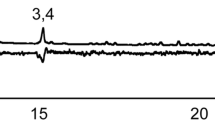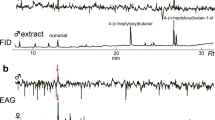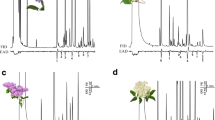Abstract
The South American fruit fly is one of the most destructive polyphagous pests in South America. In this species, males gathered in aggregations emit volatiles that attract females; however, the compounds involved in this task remain unknown. In this study, we investigated the chemical composition of the volatile blend emitted by males aiming to identify the specific compounds within this blend that elicit behavioral responses in conspecific females. For this purpose, we performed chemical and electrophysiological analyses and bioassays. The chemical analyses revealed the presence of 29 compounds in headspace samples of A. fraterculus males, of which six compounds, i.e. α-pinene, limonene, (Z)-3-nonen-1-ol, (E,Z)-3,6-nonadien-1-ol, α-farnesene and (S,S)-(−)-epianastrephin, triggered antennal depolarization in conspecific females. In laboratory bioassays, five out of eight synthetic compounds tested individually elicited more behavioral responses than a hexane control, but only the synthetic mixture composed of all EAD-active compounds triggered behavioral responses in females similar to the responses to the headspace samples of conspecific males. In an experiment under semi-natural conditions, the synthetic mixture was more attractive to females than a hexane control and equally attractive to headspace extracts of males. This study reports the identification of male volatile compounds that act as attractant for A. fraterculus females, which may be useful for the control of this pest in infested orchards.



Similar content being viewed by others
References
Adams RP (2007) Identification of essential oil components by gas chromatography/mass spectrometry. Allured Publishing Corporation, Illinois
Aluja M (1994) Binomics and management of Anastrepha. Annu Rev Entomol 39:155–178
Aluja M, Norrbom AL (2001) Fruit flies (Tephrtitidae) phylogeny and evolution of behavior. CRC Press LLC, Boca Raton
Aluja M, Díaz-Fleischer F, Boller EF, Hurter J, Edmunds AJF, Hagmann L, Patrian B, Reyes J (2009) Application of feces extracts and synthetic analogues of the host marking pheromone of Anastrepha ludens significantly reduces fruit infestation by A. obliqua in tropical plum and mango backyard orchards. J Econ Entomol 102:2268–2278
Ayasse M, Paxton RJ, Tengö J (2001) Mating behavior and chemical communication in the order Hymenoptera. Annu Rev Entomol 46:31–78
Ayres M, Ayres Jr M, Ayres DL, dos Santos AS (2007) BioEstat 5.0—Aplicações estatísticas nas áreas das ciências biológicas e médicas. Belém, Sociedade Civil Mamirauá, p 364
Břízová R, Mendonça AL, Vaníčková L, Lima-Mendonça A, da Silva CE, Tomčala A, Paranhos BAJ, Dias VS, Joachim-Bravo IS, Hoskovec M, Kalinová B, do Nascimento RR (2013) Pheromone analyses of the Anastrepha fraterculus (Diptera: Tephritidae) cryptic species complex. Flo Entomol 96:1107–1115
Cáceres C, Segura DF, Vera MT, Wornoayporn V, Cladera JL, Teal P, Sapountzis P, Bourtzis P, Zacharopoulou A, Robinson AS (2009) Incipient speciation revealed in Anastrepha fraterculus (Diptera; Tephritidae) by studies on mating compatibility, sex pheromones, hybridization, and cytology. Biol J Linn Soc 97:152–165
Dias V (2012) Compatibilidade de acasalamento de populações do complexo Anastrepha fraterculus (Diptera: Tephritidae) do Brasil. Dissertation, Universidade Federal da Bahia
El-Sayed AM (2014) The Pherobase: Database of Pheromones and Semiochemicals. http://www.pherobase.com
Howse PE (1989) Insect attractant. University of Southampton, United Kingdom
Kroiss J (2008) Chemical attraction and deception Intra- and interspecific communication in Hymenoptera. Dissertation, Universität Regensburg
Lima IS, House PE, do Nascimento RR (2001) Volatile substances from male Anastrepha fraterculus Wied. (Diptera: Tephritidae): identification and behavioural activity. J Braz Chem Soc 12:196–201
Lima-Mendonça A, AdL Mendonça, SanťAn AEG, do Nascimento RR (2014) Semiochemicals of fruit flies of the genus Anastrepha. Quim Nova 37:293–301
López-Guillén G, López LC, Malo EA, Rojas JC (2011) Olfactory responses of Anastrepha obliqua (Diptera: Tephritidae) to volatiles emitted by calling males. Fla Entomol 94:874–881
McDonald JH (2009) Handbook of biological statistics. Sparky House Publishing, Baltimore
Nascimento AS, Carvalho RS (2000) Manejo Integrado de Moscas das frutas. In: Malavasi A, Zucchi RA (eds) Moscas das Frutas de importância econômica: Conhecimento básico e aplicado. Holos, São Paulo, p 169
Nation JL (1975) The sex pheromone blend of Caribbean fruit fly males: isolation biological activity, and partial chemical characterization. J Environ Entomol 4:27–30
Nation JL (1989) The role of pheromones in the mating system of Anastrepha fruit flies. In: Robinson AS, Hooper G (eds) Fruit flies: Their biology, natural enemies and control. Elsevier Science Publisher, Amsterdam, pp 189–205
Nigg HN, Mallory LL, Simpson SE, Callaham SB, Toth JP, Fraser S, Klim M, Nagy S, Nation JL, Attaway JA (1994) Carribean fruit fly, Anastrepha suspensa (Loew), attraction to host fruit and host kairomones. J Chem Ecol 20:727–743
Norrbom AL, Korytkowski CA (2011) New species of and taxonomic notes on Anastrepha (Diptera: Tephritidae). Zootaxa 2740:1–23
Robacker DC (1988) Behavioral response of female Mexican fruit flies, Anastrepha ludens, to components of male-produced sex pheromone. J Chem Ecol 14:1715–1726
Robacker DC, Garcia JA (1990) Responce of laboratory strain Mexican fruit flies, Anastrepha ludens, to combination of fermenting fruit odor and male-produced pheromone in laboratory bioassays. J Chem Ecol 16:2027–2038
Robacker DC, Hart WG (1985) (Z)-3-nonenol, (Z, Z)-3,6-nonadienol and (S, S)-(−)-epianastrephin: male produced pheromones of the Mexican fruit fly. Entomol Exp Appl 39:103–108
Robacker DC, Hart WG (1986) Behavioral response of male and female Mexican fruit flies, Anastrepha ludens, to male-produced chemicals in laboratory experiments. J Chem Ecol 12:39–47
Robacker DC, Aluja M, Cossé AA, Sacchetti P (2009) Sex pheromone investigation of Anastrepha serpentina (Diptera: Tephritidae). Ann Entomol Soc Am 3:560–566
Rocca JR, Nation JL, Strekowski L, Battiste MA (1992) Comparison of volatiles emitted by male Caribbean and Mexican fruit flies. J Chem Ecol 18:223–244
Shailaja D, Ahmed SM, Yaseen M (1997) Comparative study of release kinetics of pheromone from polymer dispensers. J Appl Polym Sci 64:1373–1380
Shelly TE, Villalobos EM (2004) Host plant influence on the mating success of male Mediterranean fruit flies: variable effects within and between individual plants. Anim Behav 68:417–426
Vaníčková L (2012) Chemical ecology of fruit flies: genera Ceratitis and Anastrepha. Dissertation, Institute of Chemical Technology
Vaníčková L, do Nascimento RR, Hoskovec M, Ježková Z, Břízová R, Břízová R, Tomčala A, Kalinová B (2012) Are the wild and laboratory insect populations different in semiochemical emission? The case of medfly sex pheromone. J Agric Food Chem 60:7168–7176
Vera MT, Cáceres C, Wornoayporn V, Islam A, Robinson AS, De La Vega MH, Hendrichs J, Cayol JP (2006) Mating incompatibility among populations of the South American fruit fly Anastrepha fraterculus (Diptera: Tephritidae). Ann Entomol Soc Am 99:387–397
Zucchi RA (2000) Espécies de Anastrepha, sinonímias, plantas hospedeiras e parasitóides. In: Malavasi A, Zucchi RA (eds) Moscas-das-frutas de importância econômica no Brasil: Conhecimento básico e aplicado. Holos Editora, Ribeirão Preto, pp 41–48
Acknowledgments
We thank the valuable comments of the two anonymous referees in an earlier version of this manuscript. This work was supported by: FAO/IAEA, Vienna, Austria (the funding was provided to Research Contracts No. 16051 as part of the Coordinated Research Project on the Resolution of the Cryptic Species Complexes of Tephritid Pests to Overcome Constrains to SIT Application and International Trade), and Conselho Nacional de Desenvolvimento Científico e Tecnológico, Brazil (CNPq, Proc. Nos. 555094/2010-3, 308695/2011-9 and 376348/2012-7), and the Institute of Organic Chemistry and Biochemistry, Academy of Sciences of the Czech Republic, Prague (RVO: 61388963). A patent application has been filled for this discovery.
Author information
Authors and Affiliations
Corresponding author
Additional information
Handling Editor: Thomas Schmitt.
Rights and permissions
About this article
Cite this article
Milet-Pinheiro, P., Navarro, D.M.A., De Aquino, N.C. et al. Identification of male-borne attractants in Anastrepha fraterculus (Diptera: Tephritidae). Chemoecology 25, 115–122 (2015). https://doi.org/10.1007/s00049-014-0180-3
Received:
Accepted:
Published:
Issue Date:
DOI: https://doi.org/10.1007/s00049-014-0180-3




